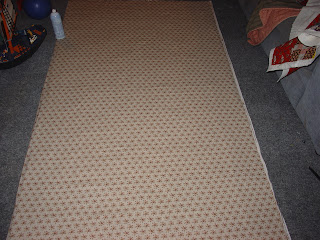It's finally spring here in Wisconsin. It's harder to find time to sew in spring and summer, because there are so many things to do in the house and garden. I've done a little spring cleaning in the house (besides the sewing room), and I'm working on problems with the main bathroom upstairs. The sequential vortex strikes again! Fixing a leaking toilet has turned into getting new vinyl and a new sub-floor, plus a new toilet to replace the 1970s blue one, and on and on.
In my small garden, the potatoes are planted and two rows of peas are up. I always want to jump for joy when I see those first new seedlings. I have LOTS of work I should be doing outside.
I do have time in the evening to sew, if I'm not too tired. Sunday night I got my newest quilt ready for quilting.
These are all the things I needed for this job--the quilt top itself, pieced in 3 sections, the backing fabric (washed), cotton batting, and basting spray. I have found that the basting spray doesn't hold very well if the fabric hasn't been washed. Probably something to do with the sizing on the fabric.
Just a word about basting spray--I am really torn about using it. It is wonderfully convenient, and saves me so much time. I absolutely hate pinning quilts. It's hard on my hands, and the pins always seem to be in the way. The quilt shifts more when pinned than when spray basted, too. On the other hand, the spray is expensive, I'm not sure I should be breathing it, and I'm concerned about the affects on the environment. Right now I'm using it, but I'm thinking about alternatives. (One thing I will NOT be doing is getting a long arm machine, even though you don't have to baste when using one!)
For my own quilts, especially the reproductions, I use Mountain Mist 100% cotton batting.
It gives the antique look I like. Old fashioned, like me.
This batting requires close stitching to keep it from shifting and lumping. (Someday I might show you my first quilt, when I didn't pay attention to this warning on the label.) I bought a case of these online a few years ago. They only cost $10.00 each (gotta love buying in bulk).
The first thing I do with this kind of quilt is spray baste the top sections to the batting. I lay them out on the floor, spray the batting (not the top), and press the top onto the batting. These sections are almost as wide as the batting. I don't have to leave a lot of extra batting around the edges when spray basting. The top and batting are solidly glued together, and don't shift.
This is all the batting I had left from this batt. I did the smallest section last, in case I didn't have enough and needed to piece it. (The toys in these pictures belong to my grandson. He and Grandpa play with them in the basement sometimes.)
After I have the batting securely basted (glued) to the top sections, I lay them with the batting side up, spray the other side of the batting with basting spray, and smooth down the backing. These sections were just the right width to use the backing lengthwise. The edges at the right and left are the selvedges. I cut each section from the backing, pressed it, and then spray basted it down.
Here are all 3 pieces, layered and basted with backing and batting, ready to quilt. I had about a fat quarter of the backing left over.
I got one block quilted and another about half done before I had to pick up my grandson from school yesterday.
If at all possible, I like to leave everything ready to go for the next time, with the needle in the quilt. Then all I have to do the next time is sit down and get to work!
Got any ideas for basting quilts? Leave a comment!




















































